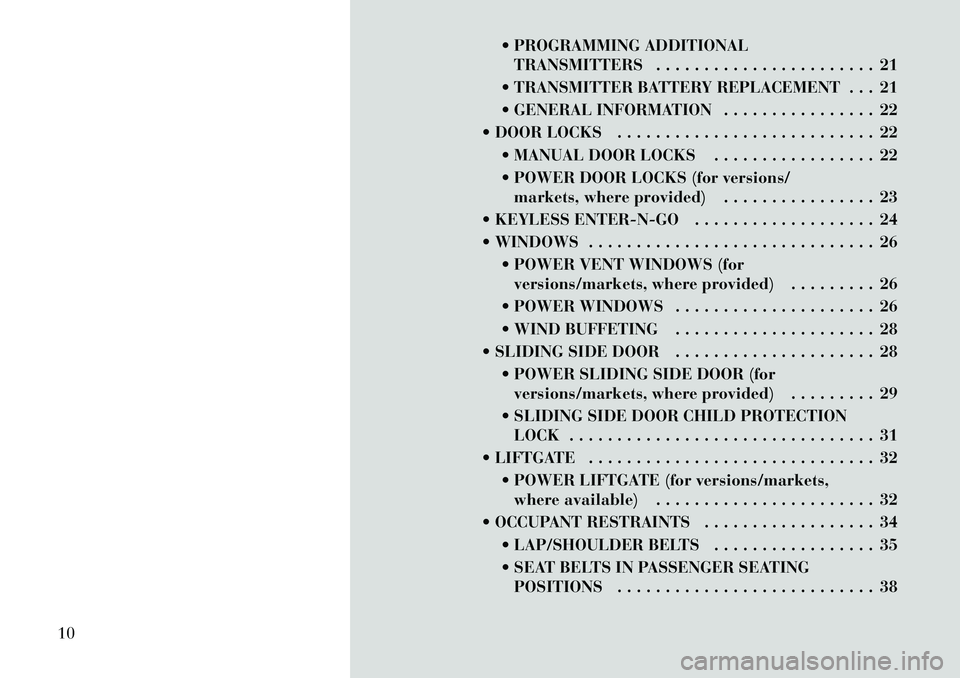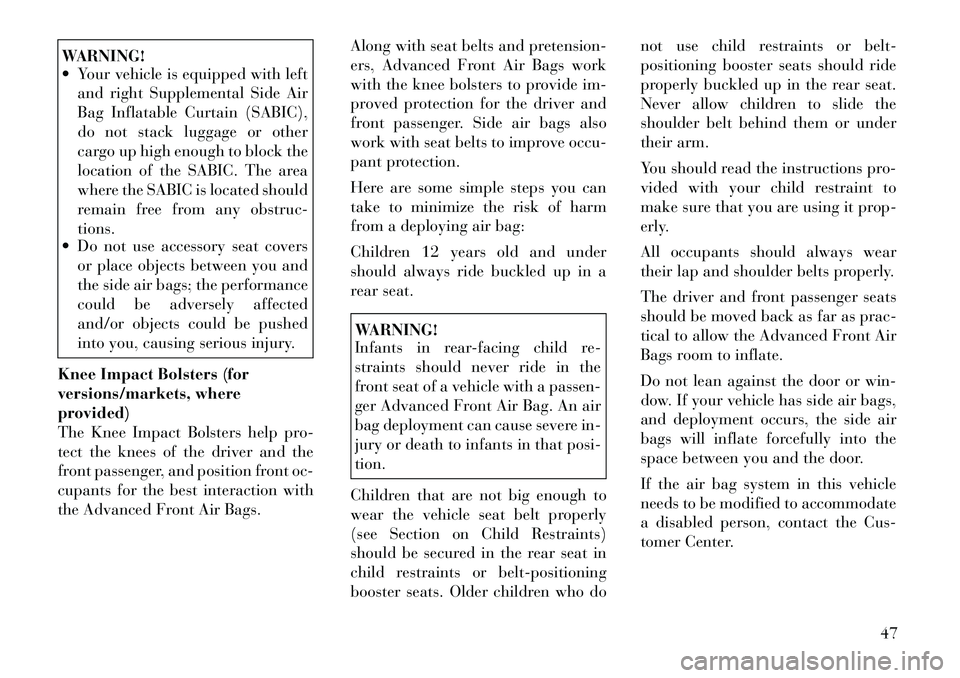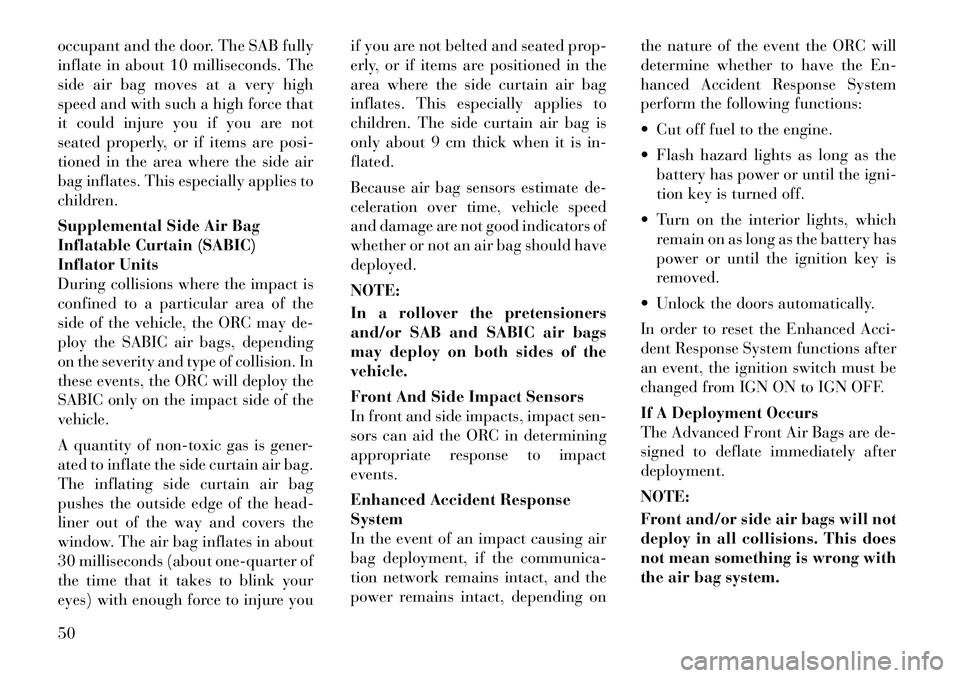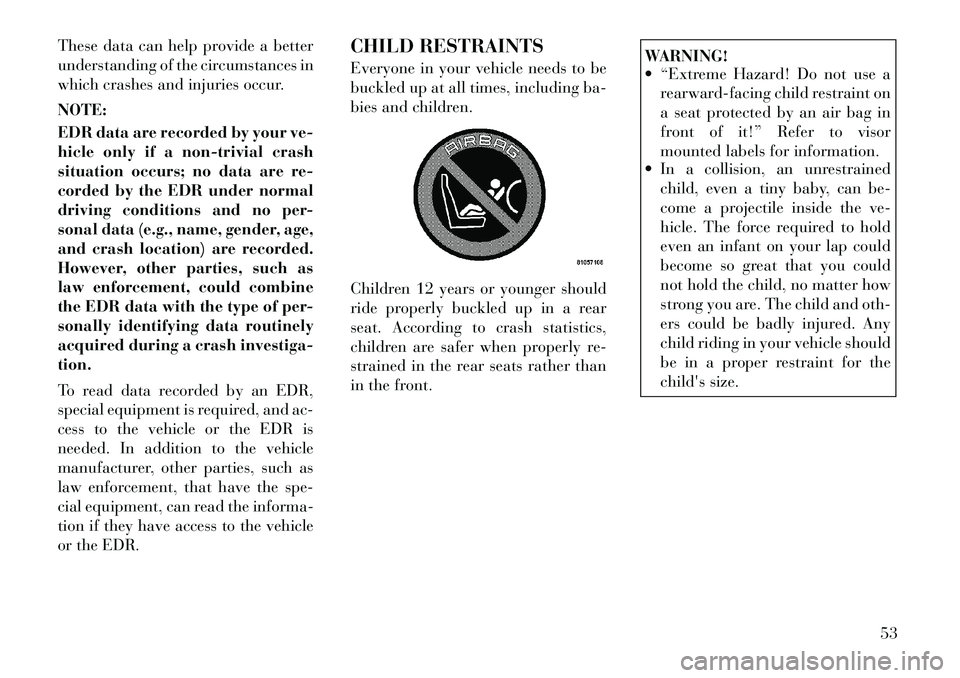child seat Lancia Voyager 2012 Owner handbook (in English)
[x] Cancel search | Manufacturer: LANCIA, Model Year: 2012, Model line: Voyager, Model: Lancia Voyager 2012Pages: 344, PDF Size: 3.95 MB
Page 16 of 344

PROGRAMMING ADDITIONALTRANSMITTERS . . . . . . . . . . . . . . . . . . . . . . . 21
TRANSMITTER BATTERY REPLACEMENT . . . 21
GENERAL INFORMATION . . . . . . . . . . . . . . . . 22
DOOR LOCKS . . . . . . . . . . . . . . . . . . . . . . . . . . . 22 MANUAL DOOR LOCKS . . . . . . . . . . . . . . . . . 22
POWER DOOR LOCKS (for versions/markets, where provided) . . . . . . . . . . . . . . . . 23
KEYLESS ENTER-N-GO . . . . . . . . . . . . . . . . . . . 24
WINDOWS . . . . . . . . . . . . . . . . . . . . . . . . . . . . . . 26 POWER VENT WINDOWS (forversions/markets, where provided) . . . . . . . . . 26
POWER WINDOWS . . . . . . . . . . . . . . . . . . . . . 26
WIND BUFFETING . . . . . . . . . . . . . . . . . . . . . 28
SLIDING SIDE DOOR . . . . . . . . . . . . . . . . . . . . . 28 POWER SLIDING SIDE DOOR (forversions/markets, where provided) . . . . . . . . . 29
SLIDING SIDE DOOR CHILD PROTECTION LOCK . . . . . . . . . . . . . . . . . . . . . . . . . . . . . . . . 31
LIFTGATE . . . . . . . . . . . . . . . . . . . . . . . . . . . . . . 32 POWER LIFTGATE (for versions/markets,where available) . . . . . . . . . . . . . . . . . . . . . . . 32
OCCUPANT RESTRAINTS . . . . . . . . . . . . . . . . . . 34 LAP/SHOULDER BELTS . . . . . . . . . . . . . . . . . 35
SEAT BELTS IN PASSENGER SEATINGPOSITIONS . . . . . . . . . . . . . . . . . . . . . . . . . . . 38
10
Page 17 of 344

AUTOMATIC LOCKING RETRACTOR MODE(ALR) . . . . . . . . . . . . . . . . . . . . . . . . . . . . . . . . 38
ENERGY MANAGEMENT FEATURE . . . . . . . . 39
SEAT BELT PRETENSIONERS . . . . . . . . . . . . . 39
SUPPLEMENTAL ACTIVE HEAD RESTRAINTS (AHR) . . . . . . . . . . . . . . . . . . . . 40
ACTIVE HOOD SYSTEM . . . . . . . . . . . . . . . . . 41
ENHANCED SEAT BELT USE REMINDER SYSTEM (BeltAlert®) . . . . . . . . . . . . . . . . . . . . 43
SEAT BELTS AND PREGNANT WOMEN . . . . . 44
SUPPLEMENTAL RESTRAINT SYSTEM (SRS) — AIR BAGS . . . . . . . . . . . . . . . . . . . . . 44
AIR BAG SYSTEM COMPONENTS . . . . . . . . . . 45
ADVANCED FRONT AIR BAG FEATURES . . . . 45
AIR BAG DEPLOYMENT SENSORS AND CONTROLS . . . . . . . . . . . . . . . . . . . . . . . . . . . 48
EVENT DATA RECORDER (EDR) . . . . . . . . . . . 52
CHILD RESTRAINTS . . . . . . . . . . . . . . . . . . . . 53
ENGINE BREAK-IN RECOMMENDATIONS . . . . . 62 Additional Requirements For Diesel Engine(for versions/markets, where provided) . . . . . . 63
SAFETY TIPS . . . . . . . . . . . . . . . . . . . . . . . . . . . 63
11
Page 36 of 344

until it is fully open and then
press the switch again.
If the power sliding door en- counters multiple obstructions
within the same cycle, the sys-
tem will automatically stop, the
power sliding door motor will
make a clicking sound until the
door has no further movement.
This clicking sound can be
stopped by pulling the inside or
outside handle. If this condition
occurs, no damage is done to the
power sliding door motor. The
power sliding door must be
opened or closed manually.WARNING!
You, or others, could be injured if
caught in the path of the sliding
door. Make sure the door path is
clear before closing the door.
Power Sliding Side Door Open
Flash
The left and right exterior hazard
lights will flash for 12 seconds when
either sliding door is opened. This will alert other drivers in the area that
passenger(s) could be entering or ex-
iting the vehicle.
The Sliding Side Door Open Flash can
be enabled or disabled by performing
the following procedure:
1. Place the Key Fob in the ignition
switch.
2. Cycle the ignition switch from ON/
RUN to OFF five times ending in the
ON/RUN position
(do not start the
engine).
3. Within 10 seconds of the final
cycle, press the HAZARD switch ON.
4. A single chime will sound to signify
that you have successfully completed
the programming.
You can turn the feature back on by
repeating the previous procedure.
Power Sliding Side Door Master
Lock Switch
To provide a safer environment for
small children riding in the rear seats,
the second row sliding door switches
and handles may be overridden by pressing the OFF side of the Master
Lock Out Switch located in the front
overhead console.
When the power sliding door master
lock switch is in the OFF position, the
power sliding side door may not be
opened or closed by pressing the
switch located on the b-pillar trim
panel, just in front of the sliding door
or activating the inside power sliding
door handle.
Overhead Console Power Sliding
Door Master Switch1 — Left Sliding
Door 3 — Right Slid-
ing Door
2 — Liftgate 4 — Master Lock
30
Page 37 of 344

SLIDING SIDE DOOR
CHILD PROTECTION
LOCK
To provide a safer environment for
small children riding in the rear seats,
the sliding doors are equipped with a
Child Protection Door Lock system.
NOTE:
When the Child Protection Door
Lock system is engaged, the door
can be opened only by using the
outside door handle even though
the inside door lock is in the un-
locked position.
To Engage the Child Protection
Door Lock
1. Open the sliding side door.
2. Slide the Child Protection Door
Lock control inward (toward the ve-
hicle) to engage the Child Protection
Door Lock.3. Repeat Steps 1 and 2 on the oppo-
site sliding door.
NOTE:
After engaging the Child Protec-
tion Door Lock, always test the
door from the inside to make
certain it is in the desired posi-
tion.
When the Child Protection Door Lock system is engaged, (even if
the inside door lock is in the
unlocked position) the door can
be opened only by using the out-
side door handle, the RKE
transmitter, the switches on the
overhead console or the switches
located on the trim panel just in
front of the power sliding door. The power sliding side door will
operate from the switches lo-
cated on the trim panel just in
front of the power sliding door,
regardless of the Child Protec-
tion Door Lock lever position. To
avoid unintentional operation of
the power sliding door from the
rear seats, press the "OFF” Mas-
ter Lock Out Switch located in
the front overhead console, next
to the driver.
WARNING!
Avoid trapping anyone in the vehicle
in a collision. Remember that the
sliding doors can only be opened
from the outside door handle or the
switches located on the trim panel
just in front of the power sliding
door when the Child Protection Door
Locks are engaged.
To Disengage the Child Protection
Door Lock
1. Open the sliding side door.
Child Protection Door Lock
31
Page 40 of 344

Gas props support the liftgate in the
open position. However, because the
gas pressure drops with temperature,
it may be necessary to assist the props
when opening the liftgate in cold
weather.
OCCUPANT RESTRAINTS
Some of the most important safety
features in your vehicle are the re-
straint systems:
Three-point lap and shoulder beltsfor all seating positions
Advanced Front Air Bags for driver and front passenger
Supplemental Active Head Re- straints (AHR) located on top of the
front seats (integrated into the head
restraint)
Supplemental Side Air Bag Inflat- able Curtains (SABIC) that span
the front, second, and third row
seating for the driver and passen-
gers seated next to a window
Supplemental Seat-Mounted Side Air Bags (SAB)
An energy-absorbing steering col- umn and steering wheel Knee bolsters/blockers for front
seat occupants (for versions/
markets, where provided)
Front seat belts incorporate preten- sioners that may enhance occupant
protection by managing occupant
energy during an impact event
All seat belt systems (except the driver’s) include Automatic Lock-
ing Retractors (ALRs), which lock
the seat belt webbing into position
by extending the belt all the way
out and then adjusting the belt to
the desired length to restrain a child
seat or secure a large item in a seat
If you will be carrying children too
small for adult-sized seat belts, the
seat belts or the ISOFIX feature also
can be used to hold infant and child
restraint systems. For more informa-
tion on ISOFIX, see ISOFIX — Child
Seat Anchorage System.
NOTE:
The Advanced Front Air Bags have
a multistage inflator design. This
allows the air bag to have different
rates of inflation based on several
factors, including the severity and
type of collision. Please pay close attention to the infor-
mation in this section. It tells you how
to use your restraint system properly,
to keep you and your passengers as
safe as possible.
WARNING!
In a collision, you and your passen-
gers can suffer much greater injuries
if you are not properly buckled up.
You can strike the interior of your
vehicle or other passengers, or you
can be thrown out of the vehicle.
Always be sure you and others in
your vehicle are buckled up prop-
erly.
Buckle up even though you are an
excellent driver, even on short trips.
Someone on the road may be a poor
driver and cause a collision that in-
cludes you. This can happen far away
from home or on your own street.
Research has shown that seat belts
save lives, and they can reduce the
seriousness of injuries in a collision.
Some of the worst injuries happen
when people are thrown from the ve-
hicle. Seat belts reduce the possibility
of ejection and the risk of injury
34
Page 44 of 344

3. Slide the latch plate upward over
the folded webbing. The folded web-
bing must enter the slot at the top of
the latch plate.
4. Continue to slide the latch plate up
until it clears the folded webbing.
Adjustable Upper Shoulder Belt
Anchorage
In the front seats and the second row
outboard seats, the shoulder belt an-
chorage can be adjusted upward or
downward to help position the belt
away from your neck. The upper an-
chorage can be adjusted upward by
pushing anywhere on the anchorage.
To move the anchorage downward,
squeeze the actuation buttons while
simultaneously pushing down on the
anchorage assembly.
As a guide, if you are shorter than
average you will prefer a lower posi-
tion, and if you are taller than average
you will prefer a higher position.
When you release the anchorage, try
to move it up or down to make sure
that it is locked in position.SEAT BELTS IN
PASSENGER SEATING
POSITIONS
The seat belts in the passenger seating
positions are equipped with Auto-
matic Locking Retractors (ALR)
which are used to secure a child re-
straint system. For additional infor-
mation, refer to “Installing Child Re-
straints Using The Vehicle Seat Belt”
under the “Child Restraints” section.
The chart below defines the type of
feature for each seating position.
Driver Center Passen-
ger
First
Row N/A N/A ALR
Second Row ALR N/A ALR
Third Row ALR Cinch ALR
N/A — Not Applicable
ALR — Automatic Locking Retrac- tor
If the passenger seating position is
equipped with an ALR and is being
used for normal usage: Only pull the belt webbing out far
enough to comfortably wrap around
the occupant's mid-section so as to
not activate the ALR. If the ALR is
activated, you will hear a ratcheting
sound as the belt retracts. Allow the
webbing to retract completely in this
case and then carefully pull out only
the amount of webbing necessary to
comfortably wrap around the occu-
pant's mid-section. Slide the latch
plate into the buckle until you hear a
"click."
AUTOMATIC LOCKING
RETRACTOR MODE (ALR)
In this mode, the shoulder belt is au-
tomatically pre-locked. The belt will
still retract to remove any slack in the
shoulder belt. The Automatic Locking
Mode is available on all passenger-
seating positions with a combination
lap/shoulder belt. Use the Automatic
Locking Mode anytime a child safety
seat is installed in a seating position
that has a belt with this feature. Chil-
dren 12 years old and under should
always be properly restrained in the
rear seat.
38
Page 45 of 344

How To Engage The Automatic
Locking Mode
1. Buckle the combination lap and
shoulder belt.
2. Grasp the shoulder portion and
pull downward until the entire belt is
extracted.
3. Allow the belt to retract. As the
belt retracts, you will hear a clicking
sound. This indicates the safety belt is
now in the Automatic Locking Mode.
How To Disengage The Automatic
Locking Mode
Unbuckle the combination lap/
shoulder belt and allow it to retract
completely to disengage the Auto-
matic Locking Mode and activate the
vehicle sensitive (emergency) locking
mode.
WARNING!
The belt and retractor assemblymust be replaced if the seat belt
assembly Automatic Locking Re-
tractor (ALR) feature or any other
seat belt function is not working
properly when checked according
to the procedures in the Service
Manual.
Failure to replace the belt and re-
tractor assembly could increase
the risk of injury in collisions.
ENERGY MANAGEMENT
FEATURE
This vehicle has a safety belt system
with an energy management feature
in the front seating positions to help
further reduce the risk of injury in the
event of a head-on collision. This
safety belt system has a retractor as-
sembly that is designed to release
webbing in a controlled manner. This
feature is designed to help reduce the
belt force acting on the occupant’s
chest.
WARNING!
The belt and retractor assembly must be replaced if the seat belt
assembly “automatic locking re-
tractor” feature or any other seat
belt function is not working prop-
erly when checked according to
the procedures in the Service
Manual.
Failure to replace the belt and re-
tractor assembly could increase
the risk of injury in collisions.
SEAT BELT
PRETENSIONERS
The seat belts for both front seating
positions are equipped with preten-
sioning devices that are designed to
remove slack from the seat belt in the
event of a collision. These devices may
improve the performance of the seat
belt by assuring that the belt is tight
about the occupant early in a colli-
sion. Pretensioners work for all size
occupants, including those in child
restraints.
39
Page 53 of 344

WARNING!
Your vehicle is equipped with leftand right Supplemental Side Air
Bag Inflatable Curtain (SABIC),
do not stack luggage or other
cargo up high enough to block the
location of the SABIC. The area
where the SABIC is located should
remain free from any obstruc-
tions.
Do not use accessory seat covers
or place objects between you and
the side air bags; the performance
could be adversely affected
and/or objects could be pushed
into you, causing serious injury.
Knee Impact Bolsters (for
versions/markets, where
provided)
The Knee Impact Bolsters help pro-
tect the knees of the driver and the
front passenger, and position front oc-
cupants for the best interaction with
the Advanced Front Air Bags. Along with seat belts and pretension-
ers, Advanced Front Air Bags work
with the knee bolsters to provide im-
proved protection for the driver and
front passenger. Side air bags also
work with seat belts to improve occu-
pant protection.
Here are some simple steps you can
take to minimize the risk of harm
from a deploying air bag:
Children 12 years old and under
should always ride buckled up in a
rear seat.
WARNING!
Infants in rear-facing child re-
straints should never ride in the
front seat of a vehicle with a passen-
ger Advanced Front Air Bag. An air
bag deployment can cause severe in-
jury or death to infants in that posi-
tion.
Children that are not big enough to
wear the vehicle seat belt properly
(see Section on Child Restraints)
should be secured in the rear seat in
child restraints or belt-positioning
booster seats. Older children who do not use child restraints or belt-
positioning booster seats should ride
properly buckled up in the rear seat.
Never allow children to slide the
shoulder belt behind them or under
their arm.
You should read the instructions pro-
vided with your child restraint to
make sure that you are using it prop-
erly.
All occupants should always wear
their lap and shoulder belts properly.
The driver and front passenger seats
should be moved back as far as prac-
tical to allow the Advanced Front Air
Bags room to inflate.
Do not lean against the door or win-
dow. If your vehicle has side air bags,
and deployment occurs, the side air
bags will inflate forcefully into the
space between you and the door.
If the air bag system in this vehicle
needs to be modified to accommodate
a disabled person, contact the Cus-
tomer Center.
47
Page 56 of 344

occupant and the door. The SAB fully
inflate in about 10 milliseconds. The
side air bag moves at a very high
speed and with such a high force that
it could injure you if you are not
seated properly, or if items are posi-
tioned in the area where the side air
bag inflates. This especially applies to
children.
Supplemental Side Air Bag
Inflatable Curtain (SABIC)
Inflator Units
During collisions where the impact is
confined to a particular area of the
side of the vehicle, the ORC may de-
ploy the SABIC air bags, depending
on the severity and type of collision. In
these events, the ORC will deploy the
SABIC only on the impact side of the
vehicle.
A quantity of non-toxic gas is gener-
ated to inflate the side curtain air bag.
The inflating side curtain air bag
pushes the outside edge of the head-
liner out of the way and covers the
window. The air bag inflates in about
30 milliseconds (about one-quarter of
the time that it takes to blink your
eyes) with enough force to injure youif you are not belted and seated prop-
erly, or if items are positioned in the
area where the side curtain air bag
inflates. This especially applies to
children. The side curtain air bag is
only about 9 cm thick when it is in-
flated.
Because air bag sensors estimate de-
celeration over time, vehicle speed
and damage are not good indicators of
whether or not an air bag should have
deployed.
NOTE:
In a rollover the pretensioners
and/or SAB and SABIC air bags
may deploy on both sides of the
vehicle.
Front And Side Impact Sensors
In front and side impacts, impact sen-
sors can aid the ORC in determining
appropriate response to impact
events.
Enhanced Accident Response
System
In the event of an impact causing air
bag deployment, if the communica-
tion network remains intact, and the
power remains intact, depending on
the nature of the event the ORC will
determine whether to have the En-
hanced Accident Response System
perform the following functions:
Cut off fuel to the engine.
Flash hazard lights as long as the
battery has power or until the igni-
tion key is turned off.
Turn on the interior lights, which remain on as long as the battery has
power or until the ignition key is
removed.
Unlock the doors automatically.
In order to reset the Enhanced Acci-
dent Response System functions after
an event, the ignition switch must be
changed from IGN ON to IGN OFF.
If A Deployment Occurs
The Advanced Front Air Bags are de-
signed to deflate immediately after
deployment.
NOTE:
Front and/or side air bags will not
deploy in all collisions. This does
not mean something is wrong with
the air bag system.
50
Page 59 of 344

These data can help provide a better
understanding of the circumstances in
which crashes and injuries occur.
NOTE:
EDR data are recorded by your ve-
hicle only if a non-trivial crash
situation occurs; no data are re-
corded by the EDR under normal
driving conditions and no per-
sonal data (e.g., name, gender, age,
and crash location) are recorded.
However, other parties, such as
law enforcement, could combine
the EDR data with the type of per-
sonally identifying data routinely
acquired during a crash investiga-
tion.
To read data recorded by an EDR,
special equipment is required, and ac-
cess to the vehicle or the EDR is
needed. In addition to the vehicle
manufacturer, other parties, such as
law enforcement, that have the spe-
cial equipment, can read the informa-
tion if they have access to the vehicle
or the EDR.CHILD RESTRAINTS
Everyone in your vehicle needs to be
buckled up at all times, including ba-
bies and children.
Children 12 years or younger should
ride properly buckled up in a rear
seat. According to crash statistics,
children are safer when properly re-
strained in the rear seats rather than
in the front.
WARNING!
“Extreme Hazard! Do not use a
rearward-facing child restraint on
a seat protected by an air bag in
front of it!” Refer to visor
mounted labels for information.
In a collision, an unrestrained
child, even a tiny baby, can be-
come a projectile inside the ve-
hicle. The force required to hold
even an infant on your lap could
become so great that you could
not hold the child, no matter how
strong you are. The child and oth-
ers could be badly injured. Any
child riding in your vehicle should
be in a proper restraint for the
child's size.
53